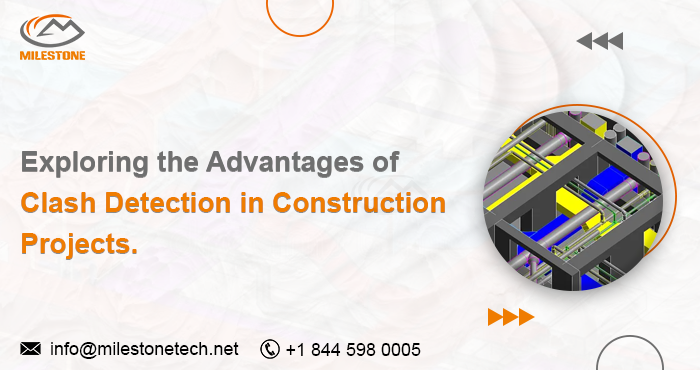Exploring the Advantages of Clash Detection in Construction Projects

In the realm of construction services, ensuring seamless collaboration among various disciplines is crucial for project success. Clash detection has emerged as a powerful tool in the construction industry, revolutionizing the way design and construction teams identify and resolve conflicts in building information models (BIM). This blog aims to delve into the advantages of clash detection, shedding light on how this technology is transforming the landscape of construction projects.
Enhanced Collaboration and Coordination:
One of the primary advantages of clash detection is its ability to enhance collaboration and coordination among diverse project stakeholders. In a construction project, multiple teams with different specialties work concurrently, such as architects, structural engineers, and MEP (mechanical, electrical, plumbing) professionals. Clash detection tools allow these teams to identify and resolve clashes or conflicts in the early stages of the design process, preventing costly errors and delays during construction.
Time and Cost Savings
Clash detection contributes significantly to time and cost savings throughout the construction lifecycle. By identifying clashes early on, project teams can streamline the decision-making process, avoiding rework and modifications during the construction phase. This proactive approach not only minimizes project delays but also reduces the overall project cost by eliminating the need for extensive revisions and alterations.
Improved Design Quality:
Efficient project execution is often synonymous with cost optimization. MEP engineering allows for careful planning and design that takes into account the project’s budget constraints. Through value engineering and cost analysis, engineers can identify cost-effective solutions without compromising on quality. This proactive approach to cost management ensures that the project stays within budgetary limits, minimizing the risk of unforeseen expenses during construction.
Clash Detection and Coordination
Clash detection tools contribute to improved design quality by ensuring that different building components align seamlessly. This results in a more accurate and optimized design, minimizing the likelihood of errors and inconsistencies. As clashes are identified and resolved during the design phase, the final construction documents are of higher quality, reducing the chances of onsite conflicts and discrepancies.
Risk Mitigation
Identifying clashes early in the design process helps mitigate risks associated with construction projects. Unresolved clashes can lead to issues such as construction delays, cost overruns, and compromised safety. Clash detection tools enable project teams to proactively address potential conflicts, reducing the likelihood of project disruptions and enhancing overall risk management.
Enhanced Communication
Effective communication is a cornerstone of successful construction projects. Clash detection facilitates improved communication among project stakeholders by providing a visual representation of clashes and conflicts. This visual clarity makes it easier for teams to understand the nature of the issues and collaborate on effective solutions. Enhanced communication leads to quicker decision-making and a more streamlined construction process.
Regulatory Compliance:
In many construction projects, compliance with building codes and regulations is non-negotiable. Clash detection tools assist in ensuring regulatory compliance by identifying clashes that may violate code requirements. By addressing these clashes early in the design phase, project teams can proactively adhere to building standards, avoiding complications and delays during the construction and inspection phases.
Conclusion:
In conclusion, the advantages of clash detection in construction projects are far-reaching. From fostering enhanced collaboration and coordination to promoting time and cost savings, clash detection has become an indispensable tool for modern construction and engineering services. As technology continues to advance, the integration of clash detection tools into the BIM process will likely become even more prevalent, further revolutionizing the way we approach and execute construction projects. Embracing these advancements is key to staying competitive and ensuring the success of construction projects in the rapidly evolving landscape of engineering services.
Follow Milestone PLM Solutions for AEC Industry Updates, CAD Tips and Global Construction News.
Milestone PLM Solutions with its exclusive delivery center in India is a global CAD, BIM outsourcing partner serving the needs of the AEC industry since 2004. MILESTONE focuses on the unique needs of clients and believe in tackling real-life problems with efficiency, smooth and ease.
The MILESTONE team can assist you with DD Set, CD Set, BIM Modeling, Rendering, walk through and more. We support multiple BIM software including AUTOCAD REVIT, Architecture cad, Vector works etc. Our approach is to provide a dedicated team for each customer over ongoing project and deliver the quality output consistently.
With our state of art technology and large talent pool of Engineers & Architects, we are developing best in class solutions for our customers across the globe. We align with your culture and values to form unbreakable partnerships and are primed for success with over 100 employees and 150 customers in the US, Europe, India, and Asia.
You can email us at info@milestonetech.net and can log in to our website www. milestonetech.net to know more about our services and our work portfolio or contact us on +1-844-598-0005
